Bordeaux red wines are great with food and  given the fact that they are made from a blend of grapes you can find a Bordeaux red to suit most dishes. There are 6 permitted grape varieties in a Bordeaux blend: Cabernet Sauvignon, Cabernet Franc, Merlot, Petit Verdot, Malbec and Carmenere.
given the fact that they are made from a blend of grapes you can find a Bordeaux red to suit most dishes. There are 6 permitted grape varieties in a Bordeaux blend: Cabernet Sauvignon, Cabernet Franc, Merlot, Petit Verdot, Malbec and Carmenere.
Today Malbec is very seldom used – although this grape is now attracting a lot more interest as the summers get hotter – and Carmenere is used in tiny quantities. With summer BBQs in mind I have found a dish that is inspired Mexican cuisine which uses limes and anchovies to give a salty zing to steak.
Steak with Lime and Anchovy Crust
4 rump steaks
6 limes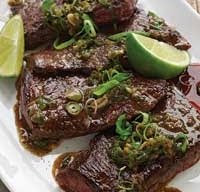
bunch of spring onions, chopped
jar of anchovy fillets, drained
2 cloves garlic, minced
¼ cup water
olive oil, salt and pepper
Squeeze 4 of the limes over the steak and rub with salt and pepper. Let sit for 10 minutes. Chop the anchovies and mix in a bowl with the chopped spring onions onions and garlic, add olive oil to make a paste.
BBQ the steak to sear them a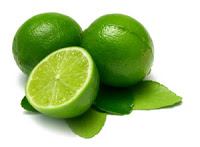 nd when done, remove the steaks and cover the tops with the anchovy paste mixture. Return the steaks to the BBQ and cook for a few minutes till the paste is charred. Squeeze the remaining limes over the steak just before eating.
nd when done, remove the steaks and cover the tops with the anchovy paste mixture. Return the steaks to the BBQ and cook for a few minutes till the paste is charred. Squeeze the remaining limes over the steak just before eating.
Limes actually originate from the Himalayan region of India and are usually sweeter than lemons. The original fruit known in English as a “lime” was citrus aurantifolia, derived from the Persian and the fruit was introduced to Europe during the Crusades.
Attempts to grow limes in Mediterranean countries were not too successful because they were not hardy enough; but they do very well in Egypt, where they are more plentiful than lemons. Although limes will ripen to an orange colour if left on the tree, they are always picked “green”, possibly to distinguish them from the lemon.
In the 18th century, Scottish naval surgeon Sir James Lind learned by his observation of long-haul sailors that citrus fruits conquered the dreaded scurvy (lack of Vit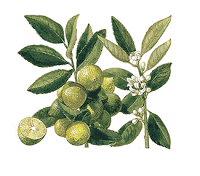 amin C) which had devastated the ranks of the British navy more than any enemy.
amin C) which had devastated the ranks of the British navy more than any enemy.
Along with rum British sailors were issued a daily allowance of lemons. Since Britain was often at war with Mediterranean countries who exported lemons, limes imported cheaply from the English colony of Jamaica were substituted as the citrus of choice.
Limes were not as effective at preventing scurvy but led over time to the nickname “limey” for all Britons.
“Limehouse”, in London’s docks, takes its name from the warehouses where the fruit was stored after arriving from the West Indies.
The tang of the limes goes well with anchovies – which get their characteristic strong flavour from the curing process. Collioure in the Languedoc Roussillon has been famous for its salt-curing of 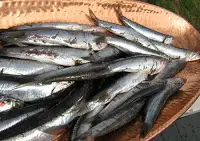 anchovies since Medieval times.
anchovies since Medieval times.
Their anchovy production became so significant that in 1466, the King Louis XI exempted the “anchoïeurs” from paying the gabelle (salt tax).
By the beginning of the 20th century hundreds were employed in around 40 anchovy salt houses and fresh catches were bought in every morning in the traditional brightly painted fishing boats called Catalans.
Nowadays only two salting houses still remain in Collioure, Ets Roques and Anchois Declaux but they continue to prepare the fragile fish in the time honoured fashion – by hand. Morocco now leads the world in canned anchovies although the industry was only initiated in Cantabria by Sicilian salters in the mid 19th century.
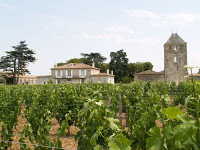 In Roman times, anchovies were the base for the fermented fish sauce called garum that was a staple of cuisine and it was produced in industrial quantities. The Romans also ate them raw as an aphrodisiac! Nowadays anchovies are a key ingredient in Caesar Salad, Spaghetti alla Puttanesca and Worcestershire Sauce.
In Roman times, anchovies were the base for the fermented fish sauce called garum that was a staple of cuisine and it was produced in industrial quantities. The Romans also ate them raw as an aphrodisiac! Nowadays anchovies are a key ingredient in Caesar Salad, Spaghetti alla Puttanesca and Worcestershire Sauce.
I would recommend Chateau Pessan 2005 (£13.34) as a brilliant match with the flavours in this dish. It is a velvety wine, deep and dense, perfectly balanced with hints of black fruits, spice, coffee, smoke, eucalyptus, pepper and oak.
The blend is 60% Merlot, 40% Cabernet Sauvignon and the wine is 1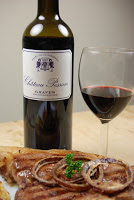 3% alcohol. Pessan is a versatile wine and will accompany game birds such as pheasant, partridge and guinea fowl; lamb and steak as well as stuffed oysters, crystallized fruits and cheese.
3% alcohol. Pessan is a versatile wine and will accompany game birds such as pheasant, partridge and guinea fowl; lamb and steak as well as stuffed oysters, crystallized fruits and cheese.
The wine is a superb buy and is starting to attract attention on the world market.
Pessan hails from Graves – which is considered to be the birthplace of claret and it takes its name from the gravelly soil beneath the vines.
This gravel is the result of glaciers from the Ice Age and can be as much as 3 metres thick. The gravels are full of quartz, ochre, white, red and pink quartzites, jasper, agate, flint and lydian which can be seen scattered on the 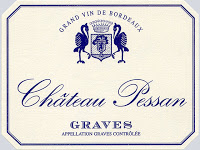 surface of the soil between the vines. The gravel reflects the sunlight, redistributing its heat onto the bunches of grapes which helps their ripening. It also offers excellent drainage.
surface of the soil between the vines. The gravel reflects the sunlight, redistributing its heat onto the bunches of grapes which helps their ripening. It also offers excellent drainage.
The château is owned by the Comtes de Bournazel who have 400 years of wine making experience. The Comtes de Bournazel are the owners of the Sauternes Second Growth Château de Malle and the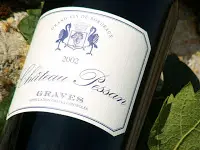 y bought Château Pessan in 1999.
y bought Château Pessan in 1999.
They embarked on intensive restoration of the ruined Château dating from the time of Louis XIV. Paul-Henry Bournazel took over in 2006 and renovated the chai and cellars built in the 18th century.
At the same time Paul-Henry concentrated his efforts on improving the wine and vineyards. The wine was not marketed until 2002 until Paul-Henry was satisfied of its quality – this paid off and the Château has won several awards for its wines since its release.

